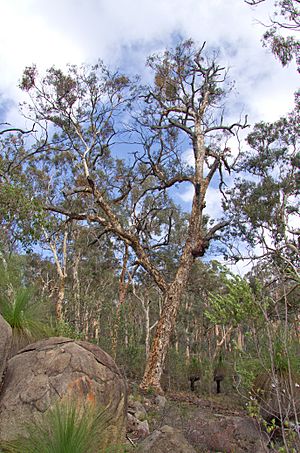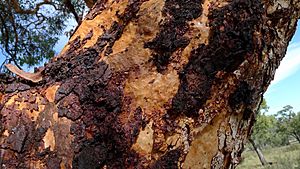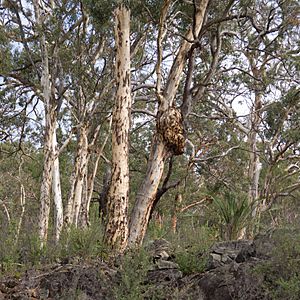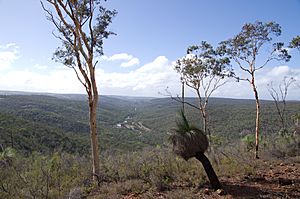Smooth bark wandoo facts for kids
Quick facts for kids Powderbark wandoo |
|
|---|---|
 |
|
| Eucalyptus accedens in the Avon Valley National Park | |
| Scientific classification | |
| Genus: |
Eucalyptus
|
| Species: |
accedens
|
The Powderbark wandoo, also known as smooth bark wandoo, is a special type of tree. Its scientific name is Eucalyptus accedens. This tree only grows in the south-west part of Western Australia.
Even though its common names sound like another tree called "wandoo" (Eucalyptus wandoo), these two trees are actually quite different. The Powderbark wandoo gets its name from the soft, talc-like powder on its bark. This powder is usually found on the protected side of its trunk. You'll often find this tree growing on rocky, higher ground.
Contents
What Does the Powderbark Wandoo Look Like?
The Powderbark wandoo is a tall tree, usually growing about 15 to 25 meters (50 to 80 feet) high. Its branches grow high up on the trunk. The trunk can be as wide as 1.5 meters (5 feet).
Its Special Bark
One of the most interesting things about this tree is its smooth bark. It's covered in a soft, talc-like powder, just like baby powder! When the bark is new, it's pale white. Then, it turns an orange color before it peels off.
Leaves and Flowers
The leaves of the Powderbark wandoo grow in a zig-zag pattern along the branches. They are a dull blue-green color on both sides. Each leaf is shaped like a spear, about 8 to 18 centimeters (3 to 7 inches) long.
This tree produces pretty white flowers. They bloom between December and April. The flowers grow in small groups of 7, 9, or 11 buds. After the flowers, the tree grows small, barrel-shaped fruits. Inside these fruits are tiny brown seeds.
How to Tell it Apart
The Powderbark wandoo looks a lot like the regular Eucalyptus wandoo. But you can tell them apart by the orange, powdery coating on the Powderbark wandoo's bark. This powder appears at certain times of the year. The Powderbark wandoo also has bigger, rounder flower buds and rounder young leaves.
Naming the Powderbark Wandoo
The Powderbark wandoo was first officially named in 1904. A scientist named William Vincent Fitzgerald described it. He had collected samples of the tree near a town called Pingelly the year before.
The scientific name accedens comes from a Latin word. It means "approaching" or "resembling." This name was chosen because the tree's bark looks similar to the bark of E. wandoo.
Where Does it Grow?
The Powderbark wandoo likes to grow in gravelly or clay soils that are on top of a type of rock called laterite. You'll often find it on stony hills or rocky slopes. It often grows above areas where Eucalyptus wandoo trees are found.
This tree grows in a wide area of Western Australia. Its range stretches from south-east of Geraldton down through the Darling Range. It goes as far south as Williams, Western Australia.
Tree Neighbors
In the woodlands where it lives, the Powderbark wandoo often grows with other trees. As mentioned, E. wandoo often grows below it. Sometimes, you might also see it with E. astringens or E. marginata.
Many different shrubs also grow under these trees. Some common ones include Hypocalymma angustifolia, Hibbertia hypericoides, Hakea lissocarpha, Acacia pulchella, Hovea chorizemifolia, Gastrolobium microcarpum, Lepidosperma leptostachyum, and Bossiaea eriocarpa.
Protecting the Powderbark Wandoo
Good news! The Western Australian Government's Department of Parks and Wildlife says that this eucalypt tree is "not threatened." This means it's not currently in danger of disappearing.
Uses of the Powderbark Wandoo
Growing it in Gardens
The Powderbark wandoo is now often sold to be planted in gardens. People use it as a shade tree or to provide shelter. Its bark is sometimes used to keep ants away. This tree can grow in many different types of soil, except for lime-rich ones. It can also handle dry weather quite well. You can buy its seeds or young plants.
Powder Power
In 2004, scientists studied the powder that collects on the tree's trunk. They wanted to see if it could stop insects and other small creatures. The tests showed that ants died much more often on paper discs covered with the powder than on plain discs. This suggests the powder might help protect the tree from some pests.
Images for kids
See also
 In Spanish: Wandoo corteza de polvo para niños
In Spanish: Wandoo corteza de polvo para niños








